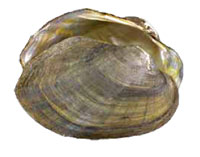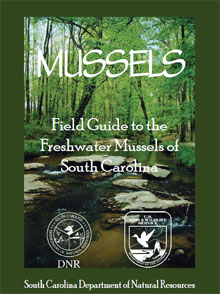Freshwater Fish - Species
Species Specific Regulations
Rayed pink fatmucket
Freshwater Fishing License required.
Rayed pink fatmucket (Lampsilis splendida)
Description: (Anatomy of a Shellfish)
Shell shape is elongate oval, greatly inflated with a shell length of 110 mm. Posterior ridge rather sharp, often with a secondary ridge, posterior slope wrinkled. Periostracum wrinkled giving the surface a fuzzy appearance, entire surface yellowish green to reddish-brown and the entire surface covered with numerous wide and narrow green rays, becoming dark brown with the rays obscured in old specimens. Nacre color varies from bluish to white but often pinkish and iridescent ranging to a light purple.
Range: This species occurs in the Savannah River Basin, the Wateree River and the Santee River, both in the Cooper-Santee River Basin and the Waccamaw River of the Pee Dee River Basin.
Average Length: 110 mm
Life Expectancy: Approximately 1-7 years
Preferred Habitat
Mussels were historically abundant in most permanent rivers and streams in North America. Sometimes, mussels can be found in temporary bodies of water such as sloughs and oxbow lakes, that occasionally receive water from rivers during flood events. Mussels are not usually found in streams that experience frequent drying or dry periods of long duration.
Food Habits
- Rayed pink fatmucket are filter feeders that remove particles from the water.
- They feed primarily on phytoplankton (algae), which they filter from the sandy or muddy bottom of streams, lakes, or canals.
- Several studies have shown that they can improve water quality by reducing quantities of excessive algae and nutrients.
Reproduction
- In most species of freshwater mussels, the sexes are separate. Males release sperm into the water column, and females take in the sperm when filtering the water.
- Fertilization occurs internally, and the female mussel remains gravid, anywhere from several weeks to several months.
- Most species of larval mussels, called glochidia, must undergo a parasitic stage in which they attach to the gills or fins of a fish in order to complete development. Some mussel species can use a variety of different fish species as hosts, while others are limited to one or very few fish species.
- In order to increase their chances of finding a suitable host, many female mussels grow an extension of the mantle flap that looks like a small fish, crayfish, insect, or worm to attract a predatory fish host. When the fish attacks, the female releases her glochidia at just the right time.
More information on mussels
Literature Cited
US Geological Survey. NAS Nonindigenous Aquatic Species
http://nas.er.usgs.gov/queries/factsheet.aspx?speciesid=92
Bogan, A. E., J. Alderman, and J. Price. 2008. Field guide to the freshwater mussels of South Carolina. (Adobe PDF - 2MB)
South Carolina Department of Natural Resources, Columbia. 43 pages


